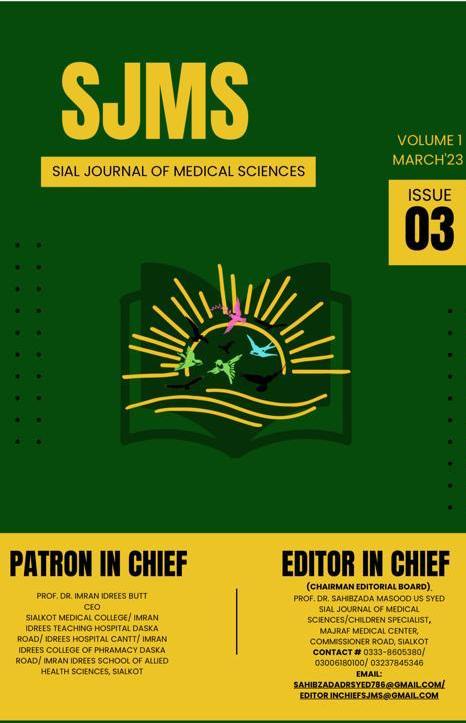FACTORS HINDERING USE OF FAMILY PLANNING METHODS AMONG WOMEN OF REPRODUCTIVE AGE IN SIALKOT CITY.
DOI:
https://doi.org/10.60127/sjms.v1i3.11Keywords:
family planning, hindering, women, perpoductiveAbstract
INTRODUCTION
The use of contraceptives is one of the major determining factor of reducing fertility. This has increased steadily over the years and currently widespread through the world, but the progress has not been the same in Affiliations terms of geographical area and is not meeting the current demand and making available various types of methods to women wishing and willing to use Globally modern contraceptives utilization has, increased in the recent past from 54% to 57%. However, estimates are much lower in Pakistan i.e. 34% of women of reproductive age are using contraceptives.
OBJECTIVES
The goal of this research is to find out the factors affecting/hindering the use of contraceptives among women of reproductive age in Sialkot City, Pakistan.
MATERIAL AND METHODS
It was a cross sectional study, conducted in the city of Sialkot. The sample size was of 100 married women ranging age group (15-49 years) having children in OPD of Allama Iqbal Memorial Teaching Hospital, Imran Idress Teaching Hospital and Mission Hospital of Sialkot. Self-administered questionnaire was used. After consent the selection of married women of reproductive age were included in study. After data collection, it was analysed manually. The variables of study were age, married women having children, education of woman and her husband. However non-willing and non-cooperative women were not included in this study. Permission of the ethical committee was sought.
RESULTS & CONCLUSION
From our study we concluded that only 74% women had knowledge about contraceptive methods and 39% women were using contraceptive methods. Majority of women were only matriculate as for as their education status was concerned. None of the illiterate women was using contraceptive methods.
Downloads
Published
Issue
Section
License
Authors retain the copyright to their work and grant the Sial Journal of Medical Sciences the right of first publication under a Creative Commons Attribution 4.0 International (CC BY 4.0) license. This license allows others to share, adapt, and reuse the work for any purpose, including commercial use, as long as appropriate credit is given to the original authors and the journal.
By submitting a manuscript, authors confirm that the work has not been published previously (except as an abstract, lecture, or academic thesis), is not under review elsewhere, and has been approved by all authors and relevant authorities. Once accepted, the article will be openly accessible under the CC BY 4.0 license, ensuring wide dissemination and reuse with proper attribution.







